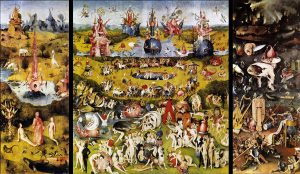Magic Realism Within Interactive Fiction
With Those We Love Alive is an interactive fiction that can easily incorporate magic realism into the world of web-based fictions. There are few expectations on what a web-based fiction should include as opposed to traditional literary novels. This could be a reason why, when interacting with a web-based fiction, we are much more accepting of possibilities and outcomes possible within the narrative.
With Those We Love Alive is about gender identity and the adaptability of our individual selves, as something we can create and form. The concept works within magical realism as we- as the protagonist, live in a world where that identity can physically change, where the evil or grotesque takes on a physical form. We see this particularly with our protagonist, as we have the choice to change her physical features like her body type- “Her majestic stag horns, her mantle of anemone tendrils, her eyes crawling with snakes”- as well as our star sign, when we choose what month our inception is, creating a metaphor for gender identity, reflecting an aspect that we accept in real life. This may seem like trivial information but in the context of a fantasy world it holds great importance. Your blood line and your own ‘worth’ as an individual are woven into these details, much like the issue of gender in our own world. Magic realism provides a way in which to reflect certain ‘truths’ back to us, as readers. The reason why these truths are successful in web-based fictions is partly due to our ability to accept the world in which we are a part of. Within print based narratives each formulation or fantastical element needs an explanation, as well as to fit into the overall reality of the world within the novel. Following each disconnected node in a web-based hyper fiction, the reader does not normally expect the same continuity or explanation, partly because of the form’s existence outside of our concept of acceptable written literature.
“Her larval skin floats across the lake like the carcass of a pale leviathan” shows a physical manifestation of evil, that her body type can change within the narrative due to her actions and creation of ‘evilness’ within the story. This idea of online fantasy creates an opportunity to be who you want to be, an ode to the transgender conceptions we have in the real world. Both fantasy and the internet are forms which suggest identity creation, with fantasy allowing the user to choose an association with a number of ‘subspecies’ of human characters and the internet allowing the user to create an identity and history that may have little or nothing to do with their actual selves. It is easy to see, therefore, why the transgender community would feel a connection with this type of new immerging form of narrative, which allows the creator to not only express their identity how they wish to online, but also use a form in which they can communicate their own experience with feeling ‘other’ or differently gendered through accepting the magic realism within the interactive fiction.



